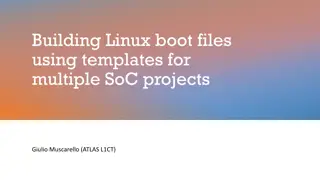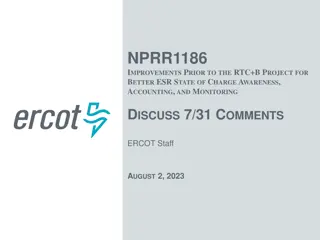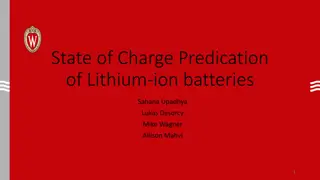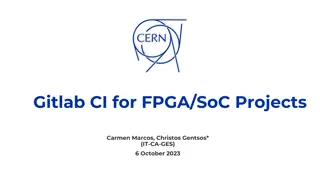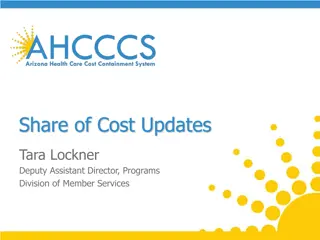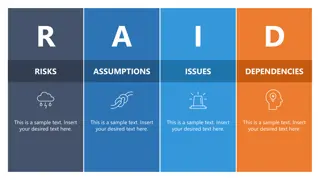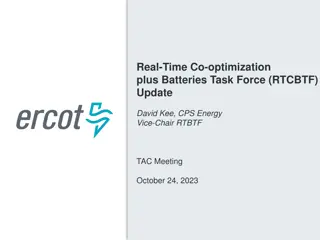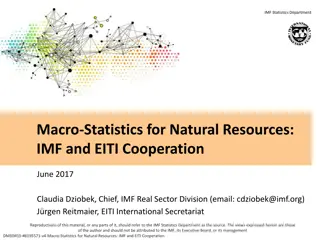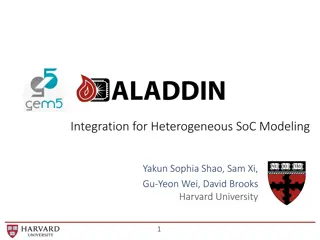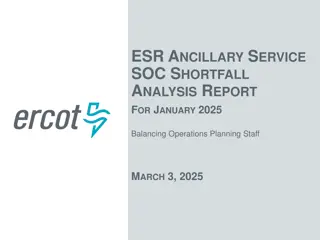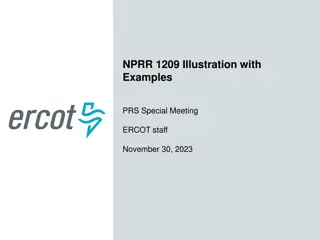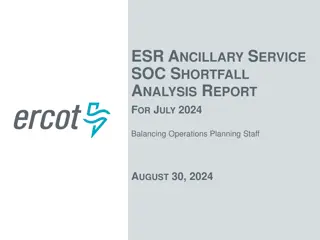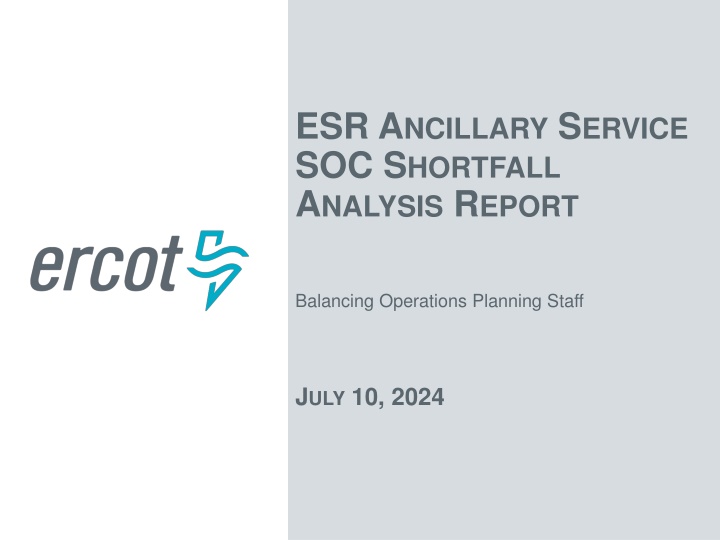
ERCOT Ancillary Service Shortfall Analysis Report Overview
"Explore the ERCOT report on Ancillary Service Shortfall Analysis regarding state of charge (SOC) improvements, NPRR1186 impact, AS obligations, SOC calculations, and failure to maintain sufficient SOC for Ancillary Services. Get insights on MW shortfall, cost calculations, and compliance metrics for ERCOT systems. Stay informed on tracking shortfall in Ancillary Service obligations due to state of charge changes." (298 characters)
Download Presentation

Please find below an Image/Link to download the presentation.
The content on the website is provided AS IS for your information and personal use only. It may not be sold, licensed, or shared on other websites without obtaining consent from the author. If you encounter any issues during the download, it is possible that the publisher has removed the file from their server.
You are allowed to download the files provided on this website for personal or commercial use, subject to the condition that they are used lawfully. All files are the property of their respective owners.
The content on the website is provided AS IS for your information and personal use only. It may not be sold, licensed, or shared on other websites without obtaining consent from the author.
E N D
Presentation Transcript
ESR ANCILLARY SERVICE SOC SHORTFALL ANALYSIS REPORT Balancing Operations Planning Staff JULY 10, 2024
ESR AS MW Shortfall Introduction NPRR1186 brought improvements to ERCOT systems to better account for state of charge (SOC). These changes now allow ERCOT s EMS to preserve SOC in SCED dispatch to maintain needed SOC to support Ancillary Service (AS) obligation in the remainder of the hour. The approved versions of NPRR1186 and NPRR1149 as approved do not consider SOC for accounting for shortfall. This led to TAC requesting a monthly report on tracking shortfall in AS obligation due to SOC. ERCOT proposes this report template to provide insights into failure to provide and failure to perform due to low or insufficient SOC. The charts on slide 3 and 4 have been built using SOC shortfall calculations over the hour which are converted to a MW shortfall value. Shortfall for each AS are assigned in this order (Non-Spin, ECRS, RRS, and Regulation). % Short of AS Responsibility is calculated as Hourly or Daily MW Short / Average Hourly Up AS Responsibility. AS Shortfall Cost ($) is calculated using the Market Clearing Price for Capacity (MCPC) of the Ancillary Services and the MW Short amount for each Ancillary Service for QSEs. ERCOT intends to share a report with production data in Aug 2024 with the implementation of NPRR1186 in ERCOT systems. The data in this report uses preliminary data prior to official go-live of NPRR1186 to demonstrate the templates we are proposing for this report. 2 PUBLIC
Failure to maintain sufficient SOC necessary to provide their Ancillary Service Obligations if system conditions require (Month over Month) An ESRs Shortfall is converted a to MW value and system-wide AS MW Short is computed at every interval (referred to as MW Short). Ancillary Service Shortfall costs are determined using MW Short and historical MCPC. A Shortfall Hour occurs when an ESR s integrated SOC shortfall exceeds the greater of 2MWhh or the lower of 8MWhh or 20% of the integrated SOC requirement over the course of an operating hour. (Proposed NPRR1186 compliance metric) Observation: [Insert Trend Observations] 3 PUBLIC
Failure to maintain sufficient SOC necessary to provide their Ancillary Service Obligations if system conditions require (April 2024) Shortfalls are converted to MW values (referred to as MW Short) and grouped by HE and Day of the month. Ancillary Service Shortfall costs are determined using MW Short and historical MCPC. Observation: Top 3 day with largest AS MW short due to SOC: April 24, 20 and 21 largest AS MW short due to SOC Top 3 day with largest AS $ short due to SOC: April 28, April 29, April 16 Top 5 Hours with AS MW short due to SOC: HE22, HE23, HE24, HE20, HE21 4 PUBLIC
Failure to perform during unit trips when carrying RRS with low SOC^. This data is sourced from the ERCOT BAL-TRE-001 FME tool considering. Low SOC is calculated using telemetered SOC, MXOS, MNOS as SOC % = ((SOC-MNOS)/MXOS)*100. * RRS-FFR performance is determined solely on sufficient MW response being provided. ^ Low SOC is set to 20% for this analysis, this is a configurable parameter. RRS-PFR Evaluated Low SOC ESRs RRS-FFR Evaluated Low SOC ESRs Failed Low SOC ESRs* Event DateEvaluated Failed ESRs Failed Low SOC ESRs Evaluated ESRs Failed ESRs* ESRs 1/1/2024 20:13 35 0 0 0 0 0 0 0 2/27/2024 9:21 50 14 1 1 8 0 0 0 2/28/2024 2:29 65 7 0 0 0 0 0 0 2/28/2024 10:15 61 8 0 0 0 0 0 0 3/12/2024 8:16 45 2 0 0 0 0 0 0 3/17/2024 15:16 67 33 1 0 0 0 0 0 3/24/2024 20:25 50 2 0 0 0 0 0 0 4/8/2024 22:29 70 13 0 0 0 0 0 0 4/10/2024 20:55 57 2 0 0 0 0 0 0 4/13/2024 18:05 44 2 0 0 0 0 0 0 Observation: In April none of the ESRs carrying RRS that were evaluated during unit trips had a low SOC. 5 PUBLIC
Failure to meet GREDP/CLREDP when carrying AS with low SOC. This table shows the GREDP and CLREDP performance in intervals where an ESR has an Ancillary Service Responsibility and is telemetering and SOC value less than 20% of their telemetered Maximum SOC. SOC % = ((SOC-MNOS)/MXOS)*100 *Tables on this slide use a synthetic data set to illustrate capability. ESR GREDP Interval Failures ESR CLREDP Interval Failures Total Intervals on Low SOC with AS Month April 2024 4 17 95 Observation: In April, there are few instances of ESRs failing GREDP with low SOC and AS Responsibility. 6 PUBLIC
Summary Now that NPRR1186 has been implemented, ERCOT plans to share a report using production data publicly starting in Aug. 2024 utilizing July 2024 data ERCOT is seeking feedback on this report template and any additional analysis that may need to be included that could help share findings. Please provide any feedback to Luis Hinojosa at jhinojosa@ercot.com by end of July. Proposed Market Meeting Timeline for sharing template: July 23, 2024 WMWG July 31, TAC 7 PUBLIC
Appendix 8 PUBLIC
Failure to maintain sufficient SOC necessary to provide their Ancillary Service Obligations if system conditions require (April 2024 by QSE) Observation: [Insert QSE Trend Observations] 9 PUBLIC
ESR failure to perform during unit trip frequency events with low SOC^ This data is sourced from the ERCOT BAL-TRE-001 FME tool and considers all ESRs evaluated by the tool. Low SOC is calculated using telemetered SOC, MXOS, MNOS as SOC % = ((SOC-MNOS)/MXOS)*100. ^ Low SOC is set to 20% for this analysis, this is a configurable parameter. Event Date BAL Evaluated Low SOC ESRs BAL Low SOC Failed ESRs 1/1/2024 20:13 4 1 2/27/2024 9:21 11 1 2/28/2024 2:29 1 0 2/28/2024 10:15 3 1 3/12/2024 8:16 1 0 3/17/2024 15:16 5 1 3/24/2024 20:25 1 0 4/8/2024 22:29 5 1 4/10/2024 20:55 2 0 4/13/2024 18:05 2 1 Observation: In April, there were two instances of ESRs failing the BAL- TRE-001 response metric. 10 PUBLIC

